Moc Chau: Highland paradise of tea hills & cultural adventures
Moc Chau Vietnam is one of the famous highland tourist destinations in northwestern Vietnam and tourists are attracted by the beautiful nature, cultural integrity and the pleasant climate. Moc Chau is a known strategic tourist destination in Son La Province and is part of the formal tourism development strategies of Vietnam due to the natural beauty and tourism potential in the area of eco-friendly tourism.
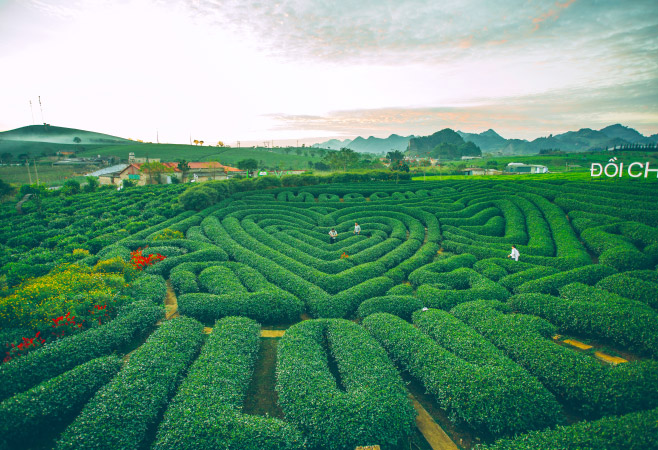
Sunset at Moc Chau heart-shaped tea hill
Strategic location in Northern Vietnam
Moc Chau is situated some 200 kilometers west of Hanoi and accessible through National Highway 6. It is also a good point of longer travel itineraries of northern Vietnam because it is on the road to Dien Bien Phu and the Laos border.
Significance as a tourism hub
Moc Chau can be visited throughout the year, although the rainy season (July–September) may bring heavy showers and slippery mountain roads.
Geography and climate
Altitude and landscape features
Moc Chau is a mountainous area with an altitude of approximately 1,050 meters above the sea level. The altitude provides fresh cool air and a broad plateau with tea hills, fruit orchards and grasslands.
Seasonal weather patterns
There are four seasons in the area. The winters are cool to cold, and the valleys are covered with mist, and the spring comes with an abundance of flowering. Summers are not as hot as in the lowlands and autumn provides clear skies and golden-colored fields.
Best visiting periods
The peak tourist seasons include:
- Late January to March – Plum and peach blossoms.
- April to June – Green tea harvests.
- October to December – White mustard flower fields and dairy farm tours.
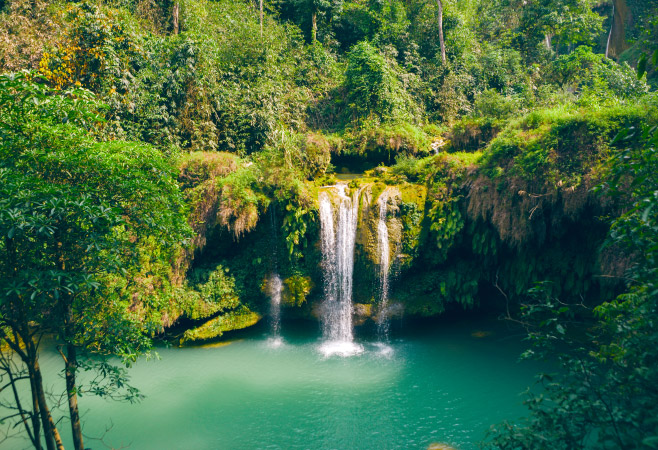
Beautiful scenery from Nang Tien waterfall, Moc Chau
Natural attractions
Moc Chau Plateau
The main attraction in the region is the plateau, which is characterized with open fields and the fresh highland air. Tourists have a chance to have carefree walks, bicycle riding and taking landscape photos.
Scenic flower seasons
The flower seasons in Moc Chau Vietnam have gained popularity in social media photography in travels. The scenery changes to white plum flowers, pink peach blossoms and mustard flowers forming colorful natural tapestries.
Tea plantations and agro-tourism
The local economy is based on tea cultivation. Organized tea tours are conducted in Tan Lap and Moc Chau Town, with tourists being able to harvest leaves, witness traditional processing techniques, and sample high-quality teas.
Moc Chau Island eco area
Moc Chau Island is not a natural island but an eco-tourism complex in Ban Ang, featuring artificial lakes, flower gardens, wooden chalets and family-friendly activities.
Moc Chau Glass Bridge
Known officially as the Bach Long Glass Bridge, this attraction holds records for length and scenic views. The glass bridge Moc Chau spans over valleys and waterfalls, providing panoramic highland perspectives.
Glass Bridge Moc Chau ticketing and safety
Sale of tickets is both on-site and online, with different rates on weekdays and weekends. The building meets the international safety requirements and the number of visitors is controlled to prevent overcrowding.
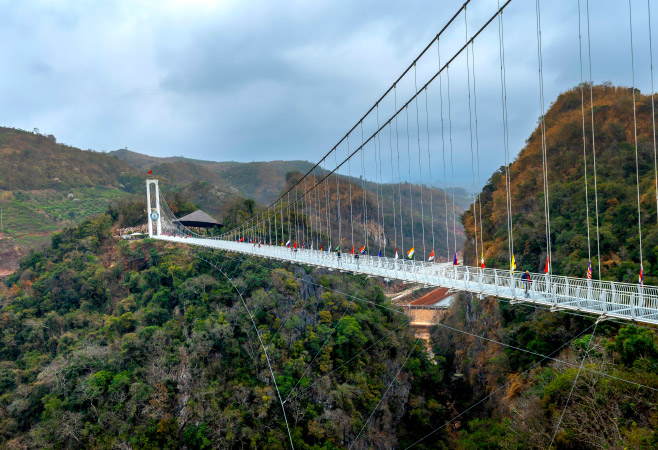
Bach Long Bridge in Moc Chau district, Son La province - The world's longest glass walking bridge
Cultural and historical aspects
Ethnic minority communities
Over a dozen ethnic groups reside in Moc Chau Vietnam, with the Thai and H’Mong communities being most prominent.
Thai People
The Thai are known for stilt houses, traditional weaving and water festivals.
H’Mong Culture
Hmong villages have terraced fields, colorful markets, and embroidery costumes.
Traditional festivals and customs
The H’Mong New Year and the Moc Chau Love Market are unique cultural events, usually held during major festivals such as the H’Mong Independence Day on September 2nd, rather than on a regular basis.
Accommodation Choices
Moc Chau Ecolodge
Moc Chau Ecolodge is a local material construction, which offers cottages overlooking tea hills. It also creates environmental awareness due to its minimized use of plastic and the creation of local employment.
Moc Chau homestay experiences
Villages such as Ban Ang offer homestays, where visitors can get the chance to experience the daily life in the country, including farming and cooking, and earn money for the local families.
Hotels and resorts in Moc Chau Town
The modern hotels and middle-range resorts located in Moc Chau Town, have facilities that are comfortable to stay long, business travel and arranged tour groups.
Activities and experiences
Trekking and hiking routes
Trails lead to highland peaks, waterfalls and minority villages. Popular spots include Dai Yem Waterfall and Pha Luong Peak.
Photography hotspots
Notable locations for photography include the heart-shaped tea hill, pine forests of Ban Ang and the glass bridge.
Local market exploration
The Moc Chau Town has markets which are perfect to buy ethnic crafts, herbal medicines and fresh produce.
Culinary experiences
Local specialties include grilled stream fish, stir-fried chayote stems, beef dishes such as bê chao, fresh salmon, Shan Tuyet tea, and a wide range of dairy products from Moc Chau’s farms.
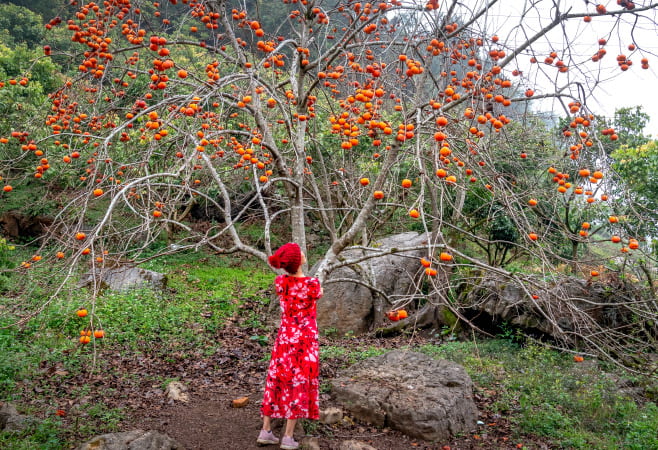
A fruit-laden persimmon tree in the Vietnamese countryside of Moc Chau, Son La province, Vietnam
Transportation and accessibility
From Hanoi to Moc Chau
Transportation options include:
- Intercity Bus – Daily departures from Hanoi’s My Dinh Bus Station.
- Private Car – Flexible schedules and direct transfers.
- Motorbike – Popular among adventure travelers.
Getting around Moc Chau
Motorbike rentals are common for independent exploration, while taxis and local guides are available for structured tours.
Travel tips for tourists
Safety and cultural etiquette
Visitors should request permission before photographing locals, dress modestly in villages and avoid loud behavior during ceremonies.
Environmental responsibility
Travelers are advised to avoid littering, conserve water and support eco-certified services.
Budget and cost estimates
Average daily costs for budget travelers range from USD 20–40 (500,000–1,000,000 VND), while mid-range hotels or eco-lodges may cost USD 50–100 per day. Luxury resorts may be higher.
FAQs
- What are the main attractions in Moc Chau?
The Moc Chau Plateau, tea plantations, Moc Chau Island and Moc Chau Glass Bridge are must-visit sites.
- How do I get to Moc Chau from Hanoi?
You can travel by bus, private car or motorbike along National Highway 6.
- Is Moc Chau suitable for family travel?
Yes, eco areas like Moc Chau Island and family-friendly hotels make it a safe and enjoyable destination.
- When should I visit Moc Chau for flower season?
Late January to March is ideal for plum and peach blossoms, while October to December features mustard flower fields.
- Are there eco-friendly accommodations in Moc Chau?
Yes, places like Moc Chau Ecolodge and various homestays prioritize sustainability.
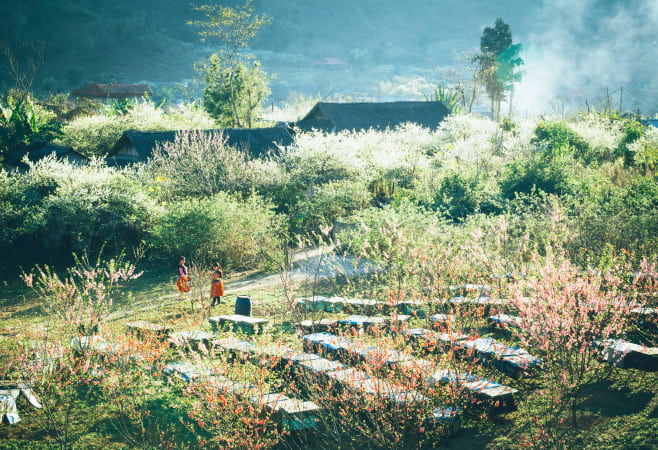
Photo taken at Moc Chau plateau, Son La, Vietnam
Conclusion
Moc Chau Vietnam is the combination of natural beauty and culture. Crossing the glass bridge Moc Chau, staying at a homestay in Moc Chau or enjoying fresh tea on the plateau, the travelers will not only find the experience scenic but also meaningful. The changing tourism infrastructure in the region guarantees comfort without compromising on authenticity, and this makes Moc Chau a must-visit destination in any travel itinerary.
Related Articles
- Moc Chau: Highland paradise of tea hills & cultural adventures
- Team building and CSR activities in Vietnam: Visa services
- Honeymoon in Vietnam: Best romantic packages for couples
- Amanoi Resort in Vietnam: Luxury retreat in Vinh Hy Bay
- Six Senses resorts in Vietnam: Ninh Van Bay and Con Dao
- Con Dao Island: A historical and natural paradise in Vietnam
- Michelin Guide in Vietnam: Ho Chi Minh City, Da Nang, Hanoi
- Vietnam vs Thailand: A comparison for Southeast Asia escape
HOW CAN WE HELP?
APPLY WITH CONFIDENCE










